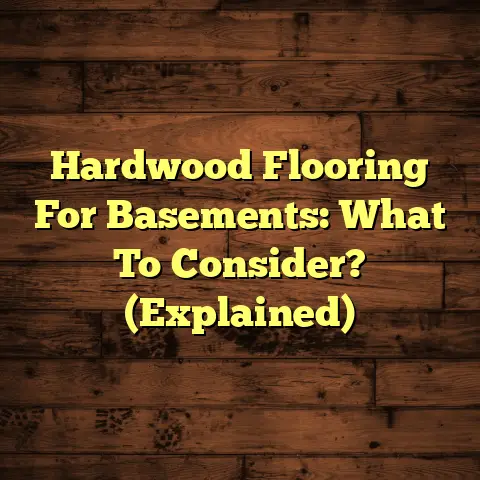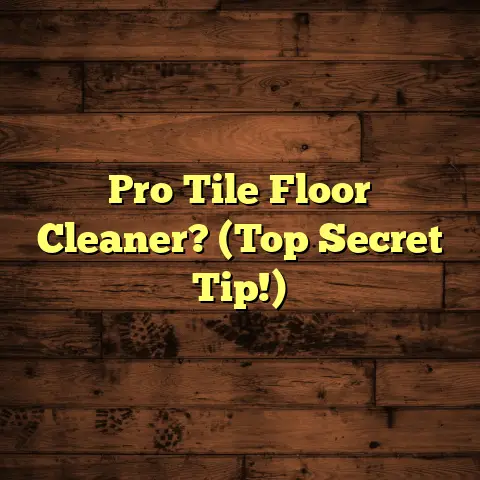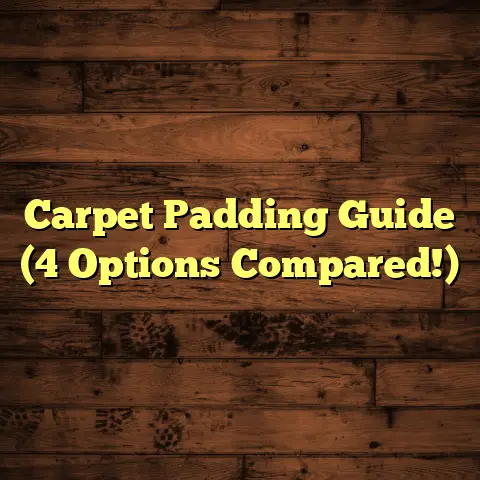Best Vacuums For Wood Floors? (6 Scratch Risks!)
I’ll never forget the day my daughter, Lily, decided to “help” with cleaning. We had just installed gorgeous, gleaming hardwood floors in our living room. The sun would stream in through the windows, highlighting the natural grain of the wood. It was the centerpiece of our home.
Then came the “help.” Lily, bless her heart, grabbed our old, beat-up vacuum – the one with the rock-hard brush roll and questionable suction. Before I could yell “Stop!”, she was off, gleefully pushing it across the brand-new floor.
The sound still haunts me. That grinding, scraping noise. When I inspected the damage, my heart sank. Tiny scratches, barely visible at first, marred the once-perfect surface. It wasn’t the end of the world, but it was a painful lesson.
That day, I learned that not all vacuums are created equal, especially when it comes to wood floors. And that’s why I’m writing this – to help you avoid the same mistake I made.
Introduction
Wood flooring. There’s a reason it’s a classic choice for homes everywhere. It’s beautiful, durable (when properly cared for), and adds a touch of elegance to any space. According to the National Wood Flooring Association (NWFA), wood flooring sales have consistently grown over the past decade, showing its enduring popularity. (Source: NWFA Industry Outlook Report)
But here’s the thing: wood floors require the right kind of maintenance. Vacuuming is a crucial part of that. It’s not just about keeping your floors clean; it’s about protecting them from scratches, dents, and other damage that can shorten their lifespan and diminish their beauty.
In this article, I’m going to dive deep into the world of vacuums for wood floors. We’ll explore what makes a vacuum “wood floor friendly,” highlight the best models on the market, and, most importantly, discuss the six potential scratch risks you need to be aware of when vacuuming your wood floors.
Understanding Wood Floors
Before we get into vacuums, let’s talk about wood floors themselves. Understanding the different types of wood flooring is essential for choosing the right cleaning tools and techniques.
-
Solid Hardwood: This is the real deal – planks made from a single piece of wood. It’s durable, beautiful, and can be refinished multiple times. Common wood species include oak, maple, and hickory.
-
Engineered Wood: This consists of a thin layer of real wood (the veneer) bonded to a core of plywood or high- density fiberboard (HDF). It’s more resistant to moisture than solid hardwood and is a great option for basements or other areas prone to humidity.
-
Laminate: While not technically “wood,” laminate flooring mimics the look of wood using a photographic applique layer under a clear protective layer. It’s affordable, scratch-resistant, and easy to install, but it can’t be refinished.
The common thread? All of these flooring types can be scratched or damaged if you’re not careful. Solid hardwood is susceptible to dents and scratches from heavy objects or abrasive cleaners. Engineered wood can be damaged if the veneer is scratched or worn through. Even laminate, despite its scratch-resistant surface, can be damaged by harsh chemicals or excessive moisture.
The Importance of Vacuuming
Why is vacuuming so important? Think about it. Every day, your floors are subjected to a constant barrage of dirt, dust, pet hair, crumbs, and other debris. This grit acts like sandpaper underfoot, gradually wearing away the finish and scratching the surface of your wood floors.
Vacuuming removes these abrasive particles, preventing them from causing damage. Regular vacuuming can also extend the life of your wood floors by preventing the buildup of dirt and grime that can dull their appearance.
How often should you vacuum? I recommend vacuuming your wood floors at least once a week, or more often if you have pets or high traffic areas. In fact, a study by the American Lung Association found that regular vacuuming can significantly reduce dust mites and allergens in the home, improving indoor air quality. (Source: American Lung Association)
Key Features to Look for in a Vacuum
for Wood Floors
Okay, so you know why vacuuming is important. Now, let’s talk about what to look for in a vacuum specifically designed for wood floors.
-
Suction Power: This is a tricky one. You need enough suction to effectively remove dirt and debris, but too much suction can actually damage your floors. Look for a vacuum with adjustable suction settings so you can dial it down for delicate wood surfaces.
-
Brush Roll Design: This is perhaps the most crucial feature. A hard brush roll with stiff bristles is a recipe for disaster on wood floors. Instead, look for a vacuum with a soft brush roll made of microfiber or felt. Even better, choose a vacuum with a brush roll that can be turned off completely for bare floor cleaning.
-
Weight and Maneuverability: A heavy, clunky vacuum can be difficult to maneuver around furniture and tight spaces, increasing the risk of bumping into things and scratching your floors. Opt for a lightweight vacuum that is easy to push and steer.
-
Filtration System: A good filtration system is important for trapping dust, allergens, and other particles, preventing them from being released back into the air. HEPA filters are especially effective at capturing fine particles, making them a great choice for homes with pets or allergy sufferers.
-
Corded vs. Cordless: This is a matter of personal preference. Corded vacuums typically offer more power and longer run times, while cordless vacuums are more convenient and easier to maneuver. Consider the size of your home and your cleaning habits when making this decision.
Top Vacuums for Wood Floors
Alright, let’s get down to the nitty-gritty. Here are some of my top recommendations for vacuums that are specifically designed for wood floors:
1. Bissell Zing Bagless Canister Vacuum
- Key Features: Lightweight, bagless design, variable suction control, hard floor tool.
- Pros: Affordable, easy to maneuver, great for small spaces.
- Cons: Canister vacuums can be cumbersome for some, smaller capacity.
- Price Range: $69.99
- User Reviews and Ratings: 4.5/5 stars on Amazon, with users praising its lightweight design and powerful suction.
2. Dyson V15 Detect Absolute
- Key Features: Cordless, powerful suction, laser dust detection, soft roller cleaner head, HEPA filtration.
- Pros: Excellent cleaning performance, advanced technology, long battery life.
- Cons: Expensive, can be heavy for some users.
- Price Range: $749.99
- User Reviews and Ratings: 4.7/5 stars on Dyson’s website, with users raving about its ability to pick up even the smallest particles of dust and debris.
3. Shark Navigator Lift-Away NV352
- Key Features: Upright vacuum, lift-away canister, swivel steering, brush roll shutoff.
- Pros: Versatile, powerful suction, easy to empty dust cup.
- Cons: Can be bulky, not ideal for small spaces.
- Price Range: $199.99
- User Reviews and Ratings: 4.6/5 stars on Amazon, with users praising its powerful suction and versatility.
4. iRobot Roomba 694 Robot Vacuum
- Key Features: Robot vacuum, self-charging, Wi-Fi connectivity, compatible with voice assistants.
- Pros: Convenient, automated cleaning, great for maintaining clean floors.
- Cons: Not as powerful as a traditional vacuum, may struggle with larger debris.
- Price Range: $274.99
- User Reviews and Ratings: 4.4/5 stars on Amazon, with users appreciating its convenience and ability to keep floors clean on a daily basis.
5. Bissell FeatherWeight Stick Lightweight Bagless Vacuum
- Key Features: Stick vacuum, lightweight, bagless design, versatile, converts to a hand vacuum.
- Pros: Inexpensive, easy to store, great for quick cleanups.
- Cons: Not as powerful as a traditional vacuum, small dust cup.
- Price Range: $33.99
- User Reviews and Ratings: 4.3/5 stars on Amazon, with users praising its lightweight design and affordability.
6. Oreck Elevate Conquer Upright Vacuum Cleaner
- Key Features: Low profile design, HEPA filtration, lightweight.
- Pros: Easy to use and move around, HEPA filtration.
- Cons: Bagged, so you have to replace bags.
- Price Range: $349.00
- User Reviews and Ratings: 4.5/5 stars on Amazon, with users praising its low profile design and HEPA filtration.
Six Scratch Risks When Vacuuming
Wood Floors
Okay, now for the most important part: the scratch risks. Knowing these potential pitfalls can help you avoid damaging your beautiful wood floors.
Risk 1: Wrong Brush Roll Type
This is the biggest culprit when it comes to scratching wood floors. As I mentioned earlier, hard brush rolls with stiff bristles can act like sandpaper on your floors, causing scratches and damage.
Solution: Always use a vacuum with a soft brush roll specifically designed for wood floors. If your vacuum has a brush roll shutoff feature, use it!
Risk 2: Excessive Suction Power
While suction is necessary for picking up dirt and debris, too much suction can actually pull and scratch the floor, especially if there are any loose particles or small rugs in the area.
Solution: Use a vacuum with adjustable suction settings and dial it down for delicate wood surfaces. You can also use a rug attachment or a bare floor tool to help distribute the suction more evenly.
Risk 3: Debris Buildup in the Vacuum
A clogged vacuum can lead to ineffective cleaning and potential scratching. When the vacuum is full of dirt and debris, it can lose suction and start dragging particles across the floor.
Solution: Empty your vacuum’s dust cup or bag regularly, and clean the brush roll to remove any tangled hair or debris. I recommend doing this after every few uses, or more often if you have pets.
Risk 4: Lack of Proper Maintenance
Neglecting to maintain your vacuum can also lead to poor performance and floor damage. Dirty filters, clogged hoses, and worn-out parts can all contribute to reduced suction and increased scratching.
Solution: Follow the manufacturer’s instructions for maintaining your vacuum. This typically involves cleaning or replacing the filters regularly, checking the hoses for clogs, and replacing any worn-out parts.
Risk 5: Improper Vacuuming Technique
Even with the right vacuum, improper technique can still lead to scratches. Vacuuming in the wrong direction, applying too much pressure, or using the wrong attachments can all damage your floors.
Solution: Vacuum in the direction of the wood grain to avoid scratching the surface. Use a light touch and avoid applying too much pressure. And always use the appropriate attachments for the job.
Risk 6: Using the Wrong Vacuum for the Job
Using a vacuum designed for carpets on hardwood can be a recipe for disaster. Carpet vacuums often have powerful suction and stiff brush rolls that can damage wood floors.
Solution: Invest in a vacuum specifically designed for wood floors. These vacuums typically have adjustable suction settings, soft brush rolls, and other features that protect your floors from damage.
Conclusion
Choosing the right vacuum for your wood floors is an investment in their longevity and beauty. By understanding the different types of wood flooring, the importance of vacuuming, and the potential scratch risks, you can make an informed decision and protect your floors from damage.
Remember to consider your specific needs and the unique characteristics of your wood floors when purchasing a vacuum. Look for features like adjustable suction settings, soft brush rolls, and lightweight designs. And always follow the manufacturer’s instructions for maintaining your vacuum and using it properly.
With the right vacuum and a little bit of care, you can keep your wood floors looking beautiful for years to come.





